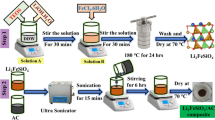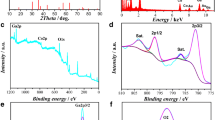Abstract
Lithium-ion hybrid supercapacitor, composed of a capacitor-type electrode and a battery-type electrode, has the potential to deliver high energy density and high power density simultaneously. In addition to electrode materials, mass matching and electrolyte are also critical to the design of a practical lithium-ion capacitor (LIC). Here, we designed commercially available pouch-type lithium-ion hybrid supercapacitors based on lithium manganate oxide (LMO) cathode and activated carbon (AC) anode with commercial-level mass loading. To optimize the performance of the LIC, meticulous mass match and electrolyte study have been performed not only in terms of energy and power densities, but also from the perspective of low-temperature performance, cycle stability, and operating voltage. Optimized LIC, using a cathode/anode mass ratio of 1/1 and an acetonitrile-based electrolyte, shows a good rate capability with 65.3% of the capacity retained even at a high C-rate of 50 C and an outstanding low-temperature performance with 46.3% of the capacity remained at −40 °C. This LIC cell delivers a maximum energy density of 9.7 W h kg−1 and a maximum power density of 8198 W kg−1 within an upper limit voltage of 2.3 V, and retains 82.8% of the initial energy at 1.0~2.3 V after 12,000 charge-discharge cycles. Moreover, enhancing the operating voltage to 3.1 V, the LIC cell displays a higher energy density of 13.9 Wh kg−1 with 59.3 Wh kg−1 of the energy density based on active materials. And the LIC cell still holds 79.1% of its initial energy at a wide working voltage of 0.5~2.5 V after 5000 cycles.





Similar content being viewed by others
References
Xu J, Cai X, Cai S, Shao Y, Hu C, Lu S, Ding S (2023) High-energy lithium-ion batteries: recent progress and a promising future in applications. Energy Environ Mater 6(5):e12450
Masias A, Marcicki J, Paxton WA (2021) Opportunities and challenges of lithium ion batteries in automotive applications. ACS Energy Lett 6(2):621–630
Li J, Fleetwood J, Hawley WB, Kays W (2021) From materials to cell: state-of-the-art and prospective technologies for lithium-ion battery electrode processing. Chem Rev 122(1):903–956
Chen L, Wang J, Yang Z, Zhang J, Hou S, Hao C, Zhang J (2022) Recent advances in flexible supercapacitors. J Solid State Electr 26(12):2627–2658
Zhu S, Zhang Z, Sheng J, Jia G, Ni J, Li Y (2023) High-quality single-walled carbon nanotube films as current collectors for flexible supercapacitors. J Mater Chem A 11(24):12941–12949
Pershaanaa M, Bashir S, Ramesh S, Ramesh K (2022) Every bite of Supercap: a brief review on construction and enhancement of supercapacitor. J Energy Storage 50:104599
Iqbal MZ, Aziz U (2022) Supercapattery: merging of battery-supercapacitor electrodes for hybrid energy storage devices. J Energy Storage 46:103823
**ng F, Bi Z, Su F, Liu F, Wu Z (2022) Unraveling the design principles of battery-supercapacitor hybrid devices: from fundamental mechanisms to microstructure engineering and challenging perspectives. Adv Energy Mater 12(26):2200594
Han P, Xu G, Han X, Zhao J, Zhou X, Cui G (2018) Lithium ion capacitors in organic electrolyte system: scientific problems, material development, and key technologies. Adv Energy Mater 8(26):1801243
Amatucci GG, Badway F, Pasquier AD, Zheng T (2001) An asymmetric hybrid nonaqueous energy storage cell. J Electrochem Soc 148(8):A930–A939
Li J, Zhang X, Peng R, Huang Y, Guo L, Qi Y (2016) LiMn2O4/graphene composites as cathodes with enhanced electrochemical performance for lithium-ion capacitors. RSC Adv 6(60):54866–54873
Chen L, Zhai W, Chen L, Li D, Ma X, Ai Q, Xu X, Hou G, Zhang L, Feng J, Si P, Ci L (2018) Nanostructured LiMn2O4 composite as high-rate cathode for high performance aqueous Li-ion hybrid supercapacitors. J Power Sources 392:116–122
** L, Zheng J, Shi Z, Qi J, Wang C (2013) Electrochemical performance of MCMB/(AC+LiFePO4) lithium-ion capacitors. Chinese Sci Bull 58:689–695
Wu M, Zhang C, Yang C, An Z, Xu J (2022) Over-heating triggered thermal runaway characteristic of lithium ion hybrid supercapacitor based lithium nickel cobalt manganate oxide/activated carbon cathode and hard carbon anode. Solid State Ionics 377:115883
Sun X, Zhang X, Zhang H, Xu N, Wang K, Ma Y (2014) High performance lithium-ion hybrid capacitors with pre-lithiated hard carbon anodes and bifunctional cathode electrodes. J Power Sources 270:318–325
Sivakkumar SR, Pandolfo AG (2012) Evaluation of lithium-ion capacitors assembled with pre-lithiated graphite anode and activated carbon cathode. Electrochim Acta 65:280–287
Zhan D, Zhang Q, Hu X, Zhu G, Peng T (2013) Single-crystalline LiMn2O4 nanorods as cathode material with enhanced performance for Li-ion battery synthesized via template-engaged reaction. Solid State Ionics 239:8–14
Zhang SS (2020) Dual-carbon lithium-ion capacitors: principle, materials, and technologies. Batteries Supercaps 3(11):1137–1146
Arnaiz M, Ajuria J (2020) Pre-lithiation strategies for lithium ion capacitors: past, present, and future. Batter Supercaps 4(5):733–748
Arnaiz M, Gómez-Cámer JL, Mijangos F, Rojo T, Goikolea E, Ajuria J (2019) Novel lithium-ion capacitor based on TiSb2 as negative electrode: the role of mass ratio towards high energy-to-power densities and long cyclability. Batter Supercaps 2(2):153–159
Surendran V, Lal A, Shaijumon MM (2021) Mass balancing of hybrid ion capacitor electrodes: a simple and generalized semiempirical approach. ACS Appl Mater Interfaces 13(44):52610–52619
Li J, Gao F (2009) Analysis of electrodes matching for asymmetric electrochemical capacitor. J Power Sources 194(2):1184–1193
Dsoke S, Fuchs B, Gucciardi E, Wohlfahrt-Mehrens M (2015) The importance of the electrode mass ratio in a Li-ion capacitor based on activated carbon and Li4Ti5O12. J Power Sources 282:385–393
Li Y, Fu D, Zhang X, Qiu S, Qin C (2016) Preparation, morphology and electrochemical performances of LiFePO4-expanded graphite composites as the positive material for Li-ion capacitor application in aqueous neutral electrolyte. J Mater Sci-Mater El 27:4417–4425
Li J, Guo J, Zhang X, Huang Y, Guo L (2017) Asymmetric supercapacitors with high energy and power density fabricated using LiMn2O4 nano-rods and activated carbon electrodes. Int J Electrochem Sci 12(2):1157–1166
Abbas Q, Béguin F (2018) Sustainable carbon/carbon supercapacitors operating down to −40 °C in aqueous electrolyte made with cholinium salt. Chemsuschem 11(5):975–984
Lee GJ, Abbas MA, Lee MD, Lee J, Lee J, Bang JH (2020) Lithiation mechanism change driven by thermally induced grain fining and its impact on the performance of LiMn2O4 in lithium-ion batteries. Small 16(29):2002292
Hua WB, Wang SN, Guo XD, Chou SL, Yin K, Zhong BH, Dou SX (2015) Vacuum induced self-assembling nanoporous LiMn2O4 for lithium ion batteries with superior high rate capability. Electrochim Acta 186:253–261
Wei Y, Tang B, Liang X, Zhang F, Tang Y (2023) An ultrahigh-mass-loading integrated free-standing functional all-carbon positive electrode prepared using an architecture tailoring strategy for high-energy-density dual-ion batteries. Adv Mater 35(30):2302086
Constable C, Coowar F, Copley M, Kendrick E, Kendrick C, Hasa I (2024) Influence of particle size and mass loading of hard carbon on sodium ion battery rate performance in industrially relevant full cells. J Electrochem Soc 171(2):023506
Lin SY, Zhang X (2015) Two-dimensional titanium carbide electrode with large mass loading for supercapacitor. J Power Sources 294:354–359
Laschuk NO, Easton EB, Zenkina OV (2021) Reducing the resistance for the use of electrochemical impedance spectroscopy analysis in materials chemistry. RSC Adv 11:27925–27936
Newell R, Faure-Vincent J, Iliev B, Schubert T, Aradilla D (2018) A new high performance ionic liquid mixture electrolyte for large temperature range supercapacitor applications (-70 °C to 80 °C) operating at 3.5 V cell voltage. Electrochim Acta 267:15–19
Lang J, Zhang X, Liu L, Yang B, Yang J, Yan X (2019) Highly enhanced energy density of supercapacitors at extremely low temperatures. J Power Sources 423:271–279
Zhu S, Wang Y, Zhang J, Sheng J, Yang F, Wang M, Ni J, Jiang H, Li Y (2023) Jahn-Teller effect directed bandgap tuning of birnessite for pseudocapacitive application. Energy Environ Mater 6(3):e12382
Ruan J, Luo S, Wang S, Hu J, Fang F, Wang F, Chen M, Zheng S, Sun D, Song Y (2023) Enhancing the whole migration kinetics of Na+ in the anode side for advanced ultralow temperature sodium-ion hybrid capacitor. Adv Energy Mater 13(34):2301509
Li Z, Yao YX, Sun S, ** CB, Yao N, Yan C, Zhang Q (2023) 40 years of low-temperature electrolytes for rechargeable lithium batteries. Angew Chem Int Ed 62(37):e202303888
Nikiforidis G, Phadke S, Anouti M (2023) Comparative internal pressure evolution at interfaces of activated carbon for supercapacitors containing electrolytes based on linear and cyclic ammonium tetrafluoroborate salts in acetonitrile. Adv Mater Interfaces 10(2):2202046
Hu C, Qu W, Rajagopalan R, Randall C (2014) Factors influencing high voltage performance of coconut char derived carbon based electrical double layer capacitor made using acetonitrile and propylene carbonate based electrolytes. J Power Sources 272:90–99
An Z, Xu X, Fan L, Yang C, Xu J (2021) Investigation of electrochemical performance and gas swelling behavior on Li4Ti5O12/activated carbon lithium-ion capacitor with acetonitrile-based and ester-based electrolytes. Electronics 10(21):2623
Matsuoka N, Kamine H, Natsume Y, Yoshino A (2021) Moderately concentrated acetonitrile-containing electrolytes with high ionic conductivity for durability-oriented lithium-ion batteries. ChemElectroChem 8(16):3095–3104
Zheng F, Li Y, Wang X (2018) Study on effects of applied current and voltage on the ageing of supercapacitors. Electrochim Acta 276:343–351
He M, Fic K, Fra E, Novák P, Berg EJ (2016) Ageing phenomena in high-voltage aqueous supercapacitors investigated by in situ gas analysis. Energy Environ Sci 9(2):623–633
Acknowledgements
The authors acknowledge the support that has been given by Zhongren Zhao, Shanghai Aowei Technology Development Co., Ltd.
Author information
Authors and Affiliations
Corresponding author
Ethics declarations
Competing interests
The authors declare no competing interests.
Additional information
Publisher's Note
Springer Nature remains neutral with regard to jurisdictional claims in published maps and institutional affiliations.
Supplementary Information
Below is the link to the electronic supplementary material.
Rights and permissions
Springer Nature or its licensor (e.g. a society or other partner) holds exclusive rights to this article under a publishing agreement with the author(s) or other rightsholder(s); author self-archiving of the accepted manuscript version of this article is solely governed by the terms of such publishing agreement and applicable law.
About this article
Cite this article
**a, H., Yu, J. & Yang, C. Optimization of mass matching and organic electrolytes for Li-ion hybrid supercapacitors based on LiMn2O4 cathode and AC anode with commercial-level mass loading. J Solid State Electrochem (2024). https://doi.org/10.1007/s10008-024-05884-9
Received:
Revised:
Accepted:
Published:
DOI: https://doi.org/10.1007/s10008-024-05884-9




